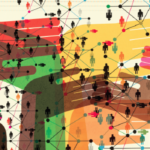To start out our conversation on multiethnic church, I did some work around clarifying terms of “multicultural’ vs. ‘multiethnic’. Because these terms are often used interchangeably, I wanted to posit our discussion around ethnicity or ethnos as the central theme to how we see our identity as the Church develop in scripture. That is, our identity as the Church over time has been shaped by the radical inclusivity of Christ across ethnic lines.
As a next step, I desire to dig deeper into how ethnicity can influence more than our individual identities. If we are seeking to form faith communities that embody expressions of ethnicity, what are we moving toward? In my work with multiethnic churches I find this is an important juxtaposition of conversation. Either churches end up with a surface value of ethnic expression (music, faces and some tradition) or they are pushed toward a deeper work of reimagining a collective faith identity. When we speak of multiethnicity we must be more holistic and specific in what we mean. Writing this from the United States, as a minority, I’ve lived in both narratives of the privilege and challenge of westernization, so I’d be remiss to not mention the effect of westernization on the Church.
Growing up in a multicultural community, I have both benefitted and been challenged by Westernization. I’ve had access to health care when needed. I have celebrated democracy by using my right of free speech through community organizing, voting and protests without fear of impingement. I’ve most notably benefitted from our educational system and access to higher education. However, this has also brought the challenge of balance: living within a dominant western narrative as a minority. (I’ve written about how that is manifested academically here). Although I have been in various leadership positions as a student, community member and scholar, I’ve been part of systems (education, faith communities and neighborhoods) which have not reflected my own experience or told my own history and perspective as a woman of color. Rather they convey our Westernized mindset shaped by dominant cultural scholars, theologians and mayors.
It is my hope to open up conversation to understand how westernization has impacted the church. What is our dominant cultural identity? Why is there even a need to talk about multiethnic church? Then I will posit a way forward through postcolonial discourse. What is postcolonial discourse and how do we reimagine a different identity for the Church?
I am not the first, nor will I be the last to add my voice to the conversation of how colonialism and westernization has impacted the church. Because of this, I will be pulling comments, thoughts and themes from Evangelical Postcolonial Conversations: Global Awakenings in Theology and Praxis, hoping to bring it into our conversation here at Missio. I’d encourage you to pick up the book and give it a read.
Understanding our Current Premise of Church Ethnicity: The Homogenous Unit Principle
The longstanding history of ‘missions’ is that we have blurred sociology (how we do life) and our message. The gospel is message – a narrative of a Kingdom coming now and giving us the hope of the not yet. With colonialism however, the gospel message became conflated with a cultural narrative – the practices of the Western world. Form and function became evaluative system that unless we could see a societal change and process (the way we identified it) it was not valid. We forgot that salvation is first a work of the Spirit, an unseen and internal work. In trying to transform people to the likeness of God we imagined that God in our own (Western) image. John Yoder[1] speaks to the dilemma of this mindset:
To reject the “confusion of Gospel and culture” is to suggest there could be a gospel that is acultural, which would have no cultural presuppositions or definition or impact. This is as unacceptable as the idea that Jesus or the early church were apolitical.
Fast-forward a few hundred years and this expression of sameness becomes most evident through the Homogenous Unit Principle (HUP). Tim Chester[2] summarizes this well:
In The Bridges of God [McGavran] states: ‘People become Christian fastest when least change of race or clan is involved’. In Understanding Church Growth (1970, 3rd Ed. 1990), which he co-wrote with C. Peter Wagner, this observation has become the ‘Homogeneous Unit Principle’. Empirical evidence, they argue, ‘people like to become Christians without crossing racial, linguistic or class barriers’. As a result homogenous churches grow fastest. Homogeneous churches are those in which all the members are from a similar social, ethnic or cultural background. People prefer to associate with people like themselves – ‘I like people like me’. And so we should create homogenous churches to be effective in reaching people.
We have a need for conversation about multiethnic because historically, our church growth and planting models are based on rapid growth and saliency, both are more easily attained through the HUP. The HUP model carries the Western values of growth and efficiency. From this I observe two leading consequences.
First, it’s relegated diversity to ethnic specific groups. The siloing of ethnic specific churches has reinforced homogeneity throughout the Church in both marginalized and dominant cultural groups. Secondly, it reflected the dominant ethnic identity (in this case White) as the normative method of gathering and worship. The end result of this make it hard to separate (and recognize) the ways our dominant culture has become institutionalized in organizational practices. Moving non-dominant groups to a marginalized space institutionalizes “normal” as being set by dominant culture.
Moving Forward: Reimagining the Ethnic Identity of Church together
So how can this be redone? An important element in postcolonial work is the idea of imagination. Colonized and marginalized people have had to re-imagine their identity, faith and communities to express themselves in dominant cultural settings. This imagination produces a hybrid identity – a democratic expression of multiple affiliations of cultural citizenship. Hybridity translates, and therefore reinscribes, the social imaginary[3]. It is an identity which deconstructs the dominant structure of power in a culture in order to reconstruct a collective identity.
However, the marginalized need partnership to do this. It is not a system of power-over or power-under, but we must strive to become co-laborers as we reimagine identity together. For some, that will mean giving up their seat at the proverbial table. For others, it will mean stepping forward even though they have traditionally been silent. Either way, the space must be made and exchanged, and this space must be co-created. 'We must strive to become co-laborers as we reimagine identity together.' - @aquietstrength Click To Tweet
I think of it as a larger movement of Philippians 2– where Christ humbled himself to take on the position of those with less power. What if, in modeling that humility, the Western church invited others to reimagine our identity together? What if we modeled partnership and interdependence, like the Trinity, with our marginalized sisters and brothers? In the Importance of Postcolonial Conversations in Evangelicalism, Steven Hu challenges the church. Why is this work of re imagination needed for the Evangelical church? He states: “If our discourse continues to remain in the domain of the West, the resultant theology will be powerless to address the issues of the global church. To be conversant with the world, evangelical theology must find new dialogue partners.”[4]
We need diversity in more than just representation and congregations. It’s time for a deeper work of understanding our identity in Christ through a shared imagining of the Church can be. The West has a powerful platform to influence theology, church planting and worship.
It’s time to invite marginalized voices in our own nation (as some already have), and model what these postcolonial conversations can look like.
— [Photo: Ryan Hickox, CC via Flickr]







Missio Alliance Comment Policy
The Missio Alliance Writing Collectives exist as a ministry of writing to resource theological practitioners for mission. From our Leading Voices to our regular Writing Team and those invited to publish with us as Community Voices, we are creating a space for thoughtful engagement of critical issues and questions facing the North American Church in God’s mission. This sort of thoughtful engagement is something that we seek to engender not only in our publishing, but in conversations that unfold as a result in the comment section of our articles.
Unfortunately, because of the relational distance introduced by online communication, “thoughtful engagement” and “comment sections” seldom go hand in hand. At the same time, censorship of comments by those who disagree with points made by authors, whose anger or limited perspective taints their words, or who simply feel the need to express their own opinion on a topic without any meaningful engagement with the article or comment in question can mask an important window into the true state of Christian discourse. As such, Missio Alliance sets forth the following suggestions for those who wish to engage in conversation around our writing:
1. Seek to understand the author’s intent.
If you disagree with something the an author said, consider framing your response as, “I hear you as saying _________. Am I understanding you correctly? If so, here’s why I disagree. _____________.
2. Seek to make your own voice heard.
We deeply desire and value the voice and perspective of our readers. However you may react to an article we publish or a fellow commenter, we encourage you to set forth that reaction is the most constructive way possible. Use your voice and perspective to move conversation forward rather than shut it down.
3. Share your story.
One of our favorite tenants is that “an enemy is someone whose story we haven’t heard.” Very often disagreements and rants are the result of people talking past rather than to one another. Everyone’s perspective is intimately bound up with their own stories – their contexts and experiences. We encourage you to couch your comments in whatever aspect of your own story might help others understand where you are coming from.
In view of those suggestions for shaping conversation on our site and in an effort to curate a hospitable space of open conversation, Missio Alliance may delete comments and/or ban users who show no regard for constructive engagement, especially those whose comments are easily construed as trolling, threatening, or abusive.